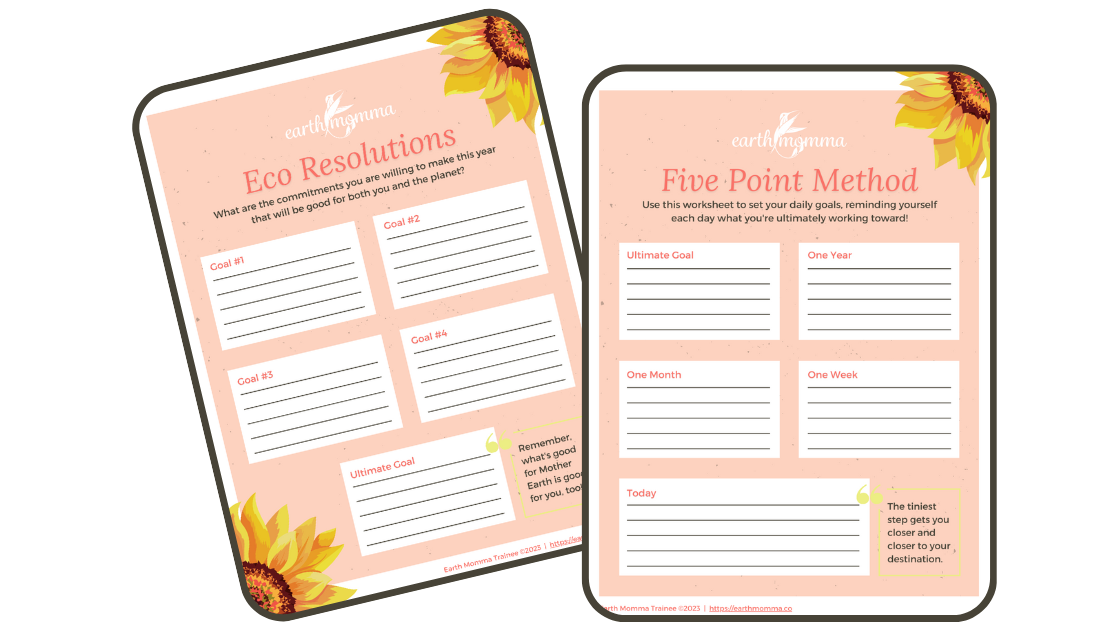Making Eco Resolutions for the New Year

Throughout my life, I have learned that there are two types of people in this world – there are those who write New Year's Resolutions, and those who gag at the mere thought of it.
Personally, I love nothing more than sitting down at my desk with a fresh sheet of paper and my favorite pen to write down my deepest desires for the coming year. Throughout the years, my annual resolutions have evolved to include more than just "fitting into my favorite jeans" or "getting a boyfriend." Now, I do my best to create meaningful goals that I know are realistic for me to accomplish. In fact, I am happy to report that I accomplished 4/5 of my resolutions from last year! YAY!
This year, I've decided to level up my resolution-making game and focus on creating eco-resolutions.
What are eco-resolutions, you might ask?
Eco-resolutions are commitments a person makes at the beginning of every year that are eco-friendly, sustainable and generally good for people and planet.
Ditch the vain resolutions this year and commit to making the planet a little cleaner and a little healthier for everyone to enjoy!
Not sure where to start? Check out the list below for some recommended eco-resolutions:
Minimize Food Waste
Did you know that if food waste was a country of its own, it would be the third largest contributor of greenhouse gases behind China and the United States? That's bananas! ((Pun intended))
Something you can do to reduce your food waste is plan your meals in advance before going grocery shopping, and make a shopping list. The most important part of this? Commit to only purchasing what is on your shopping list, otherwise this will not work for you! This way, you know that you will use all of the food that you bought at the market.
Refuse Single-Use Plastics
Single-use plastics are plastic items that are used for only a few moments, then tossed in the garbage to stay perfectly preserved for hundreds of years. We are producing over 300 million tons of plastics every year, half of which is created for single-use purposes. As a culture, we have developed a disposable and convenience-focused lifestyle that will ultimately ruin our environment.
Some single-use plastics you can begin refusing are plastic shopping bags, plastic straws, plastic utensils, plastic toothbrushes – you name it! Now, I'm not asking that you to go without these items – my dentist would kill me if he thought I was telling people to ditch their toothbrushes! No, what I am asking is that you find a reusable alternative to these items that are made from sustainable materials and will give you years of use, instead of the average 15 minutes.
Shop Secondhand First
Although there's always been a bit of a social stigma attached to pre-owned or used items, there are many compelling reasons to buy secondhand items! My top reason for shopping secondhand is the positive benefits it has for the environment. Why buy a new pair of jeans, electronic device or piece of furniture made from virgin materials when you could save those resources and purchase something that has already been created?!
Not only does secondhand shopping help preserve our limited resources, it also helps lessen the load on our landfills. The average American throws away approximately65 poundsof clothing and bedding, amounting to almost six percent of all municipal waste. Why toss a perfectly good piece of clothing or appliance into the garbage when someone else might benefit from using it?
And, secondhand shopping is way cheaper. It's definitely a win-win situation, people!
Consume Less Meat and Dairy
Many climate scientists agree that factory farming contributes massively to climate change and global warming. In 2017, a group of 200 experts in disciplines from nutrition and animal welfare predicted that without a reduction in meat consumption, agriculture is on track to gobble up half of the world's carbon budget! [1]
We have to remember that factory farming contributes to a wide variety of sources of carbon dioxide, producing tons of greenhouse gases throughout the supply chain. For example, forest clearance to grow the crops and rear the animals reduces the amount of trees available for removing carbon dioxide from the air – and once those trees are cut, the carbon dioxide that was once stored in them is released back into the atmosphere! But carbon dioxide isn't the only issue – livestock farming produces 37% and 64% of our global methane and ammonia emissions, respectively.[2]
One of the best ways to reduce your personal contribution to factory farming produced greenhouse gases is reducing your meat and dairy consumption. In fact, merely reducing your meat consumption by one day per week will save an average of 1,915 pounds of carbon dioxide, which is nearly one ton of CO2![3]
I'm not here to tell you to go vegetarian or vegan overnight, as I am not willing/able to do that myself (more on that in another post). If you are not ready to adopt an entirely plant-based diet, or just not interested in doing so, I ask that you at least try to consume less meat and dairy. Start with introducing one vegetarian recipe per week, and let it evolve naturally from there. The world will thank you for it in the long run!
Avoid Fast Food Restaurants
Something that I struggle with personally is fighting the urge to stop by a fast food restaurant on my way home from work every day to pick up dinner, even though I have a fridge full of food waiting to be cooked at home. Not only does this habit contribute to food waste that ultimately ends up in the landfill, but it also creates a tremendous amount of unnecessary packaging waste!
Think about it – every morning you stop by McDonald's for a Sausage McMuffin, Fruit & Yogurt Parfait and a small cup of water. Every item you ordered comes individually packaged in materials that cannot be recycled, then placed in a paper bag filled with condiment packets, napkins and straws (even when you don't ask for them). And don't get me started on the carbon emissions created throughout the fast food supply chain!
As with the previous tip of reducing your meat and dairy intake, I am not expecting you to make a drastic change overnight. If fast food is your only option, due to monetary reasons or time poverty, I totally get it. Like I said before, this is something that I struggle with regularly, especially when my anxiety is through the roof and I can't even fathom the thought of standing over a stove for an hour. Something you might want to try is pausing before pulling into that drive-thru and asking yourself if this is the best option for you at this moment in time. Then, accept your answer and move on with your day.
Some advice on how to keep up with your eco-resolutions?
Friends, remember that annual resolutions are just goals with a different name. Thus, don't feel guilty for not following them to a T! If you find yourself shopping at Walmart for a t-shirt because it's quick and easy, or if you forget to say "no straw" at dinner one night, don't beat yourself up about it!
As with all goals, it's best to focus on one eco-resolution at a time. Once you've mastered one, move on to the next! I wouldn't recommend taking them all on at once; you may become overwhelmed and just give up on all of them. Trust me, it happens to the best of us.
Another method that might help you stick to your eco-resolutions this year is creating some accountability. Studies show that people are more likely to stick to their goals if they share them with others. With this in mind, I suggest posting your eco-resolutions on your social media pages and sharing them with the world! And if you'd like to add a layer of support, please use the hashtag #eco-resolutions and tag me @earthmommatrainee to share your goals with the Earth Momma community.
We'd be more than happy to be your support system 😊
Looking for a little more support? Download the Earth Momma Eco-Resolutions Worksheet below!

Use this worksheet to identify four goals (aka eco-resolutions) to focus on throughout the year, making sure that they tie in to one ultimate goal.
Once you've done that, use the Five Point Method provided in the worksheet to break down each individual goal into a smaller yearly, monthly, weekly and daily goals or tasks that will help you achieve the larger goal. Try it out and let me know how it goes in the comments!
The most important piece of advice I can give you is to cut yourself some slack if you make a mistake; transitioning to a green lifestyle takes time and commitment. Hopefully setting some annual eco-resolutions will help you make that transition a little easier!

